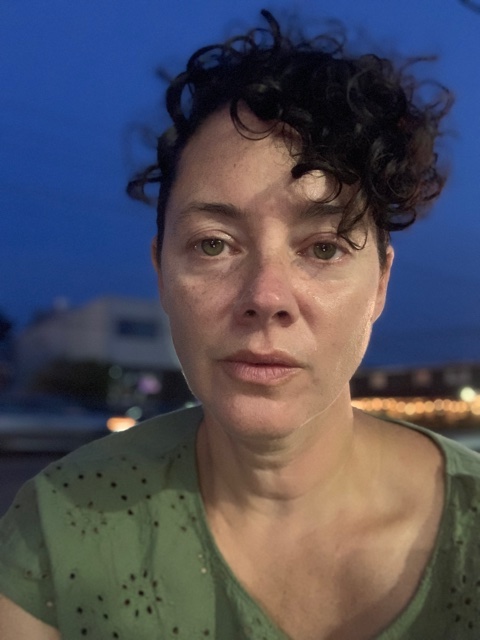This article is part of a regular series of conversations with the Review’s contributors; read past ones here and sign up for our email newsletter to get them delivered to your inbox each week.
On December 9, 2021, we published an essay by Nicole Rudick on the artist Rosemary Mayer, whose large fabric sculptures and temporary outdoor installations conveyed an expansive feminist vision. In different mediums, Mayer and her sister, the poet Bernadette Mayer, explored similar concerns, “threading personal memorials within the long span of history, thereby giving form and shape, however tenuous, to the residual traces of a life, whether their own lives or those of women in the past,” Rudick writes.
Rudick first encountered Mayer through the diary she kept during the year 1971, when the artist was twenty-eight and still developing the ideas that would be realized in her most ambitious works. “I found it engrossing—a fascinating and genuine mix of searching and doubt and desire and artistic ferment,” she told me in an e-mail this week:
She wanted a romantic relationship but didn’t want it to impinge on her creative life, she wrote about wanting to be famous but really just wanted her work recognized, and she wasn’t willing to compromise it in order to make it more marketable. Though her situation was different from mine, I could relate to her uncertainty and yearning to be recognized on her own terms. It’s too easy to overlook people who are ambitious but perhaps not overtly so.
In her articles for the Review, Rudick has discussed artists and writers whose work, in form and content, breaks convention, or otherwise refuses to be marketable: the raunchy comics and zines of Julie Doucet and Simon Hanselmann, the stitched and embroidered photography collages of Bea Nettles, the overlooked women writers of science fiction. “In life, I’ve always sat closer to the weirdo end of the spectrum,” Rudick admitted; during her time as an editor at Bookforum and Artforum, between 2002 and 2009, she was drawn to the “more unusual, experimental writing” of the small presses. For the two issues of The Paris Review that she helmed in 2018, she sought out diverse and unexpected voices, including the art of Etel Adnan and a posthumous story by Ursula K. Le Guin. “I’ve mostly stumbled into—and am still stumbling into—discovering the writers and artists I admire.”
The French writer Nathalie Léger, whose work in translation Rudick reviewed earlier this year, is exemplary of that unusual, experimental sensibility; in Léger’s uncategorizable, semi-biographical writings on female artists, details of her own mother’s traumatic 1974 divorce surface. “I don’t think the work of every writer or artist can be examined from the point of view of their life,” Rudick told me, but she often finds herself dealing with subjects who “engage directly with their own biographies.”
Like Léger, Rudick has been particularly interested in women’s art and writing of the 1970s. “A good deal of it hasn’t yet been meaningfully addressed,” she said. “It was a transformative decade for the women’s movement, as well as for LGBTQ rights, and the way this tension, between work and life, plays out within that social and political crucible is of special interest to me.” It was a period in which women writers and artists were mining their own lives for material and making art that, as Rudick wrote of Nettles’s collages, “[gave] shape to the overlap, particular to women, of domestic, public, and private worlds.”
Her own interest in the era of feminism’s second wave is personal as well as political:
I often think about my mother, who taught biology at the university level and dealt with decades of professional and personal negligence—I listened to her stories at the dinner table every night—and I think about my own mixed professional experiences.
Before the pandemic, in September 2019, Rudick visited the archive of the French-American artist Niki de Saint Phalle in San Diego, and she has been assembling its contents into a book that will be published this February. The project is a “visual life,” both a biography and autobiography, Rudick explained: in the drawings and writing behind Saint Phalle’s colorful, monumental sculptures, “I found a voice—her voice—which I’ve never quite encountered in exhibition catalogues of her art.”
Rudick was thrilled by the potential to allow Saint Phalle to tell her own story, rather than rely on the accounts of critics and hagiographers. She took inspiration from Ruth Scurr’s biography of John Aubrey, My Own Life, in which Scurr curated the seventeenth-century antiquarian’s own writings into an intimate portrait of their author.
Rosemary Mayer, too, plumbed history for intimate connections across time; among her many such projects was a translation of the sixteenth-century diary of the Florentine artist Jacopo Pontormo, a figure with whom she felt a creative kinship. Alongside his entries, she added images of her own work, writing that “I wanted his language and mine to disappear into his days.” In her essay, Rudick writes that, for Mayer, “Pontormo’s diary may have been a model for lifting off from the earth, a way of feeling free without letting go completely.”
Advertisement
Critic, translator, artist as interlocutor; the unorthodox approach has been fruitful, and freeing, for Rudick as well. “Because I put the story together, I think of the book as a collaboration between Niki and me,” she said. “Collaboration was an important element to her work, so it seemed fitting to imagine that we worked on it together.”


